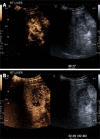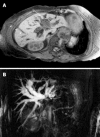Imaging of liver cancer
- PMID: 19294758
- PMCID: PMC2658841
- DOI: 10.3748/wjg.15.1289
Imaging of liver cancer
Abstract
Improvements in imaging technology allow exploitation of the dual blood supply of the liver to aid in the identification and characterisation of both malignant and benign liver lesions. Imaging techniques available include contrast enhanced ultrasound, computed tomography and magnetic resonance imaging. This review discusses the application of several imaging techniques in the diagnosis and staging of both hepatocellular carcinoma and cholangiocarcinoma and outlines certain characteristics of benign liver lesions. The advantages of each imaging technique are highlighted, while underscoring the potential pitfalls and limitations of each imaging modality.
Figures









References
-
- Vauthey JN, Klimstra D, Blumgart LH. A simplified staging system for hepatocellular carcinomas. Gastroenterology. 1995;108:617–618. - PubMed
-
- Bosch FX, Ribes J, Borras J. Epidemiology of primary liver cancer. Semin Liver Dis. 1999;19:271–285. - PubMed
-
- Vauthey JN, Blumgart LH. Recent advances in the management of cholangiocarcinomas. Semin Liver Dis. 1994;14:109–114. - PubMed
Publication types
MeSH terms
Substances
Grants and funding
LinkOut - more resources
Full Text Sources
Medical

